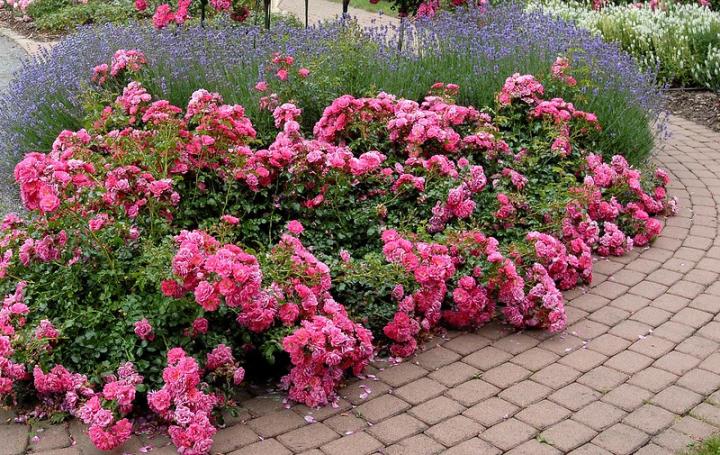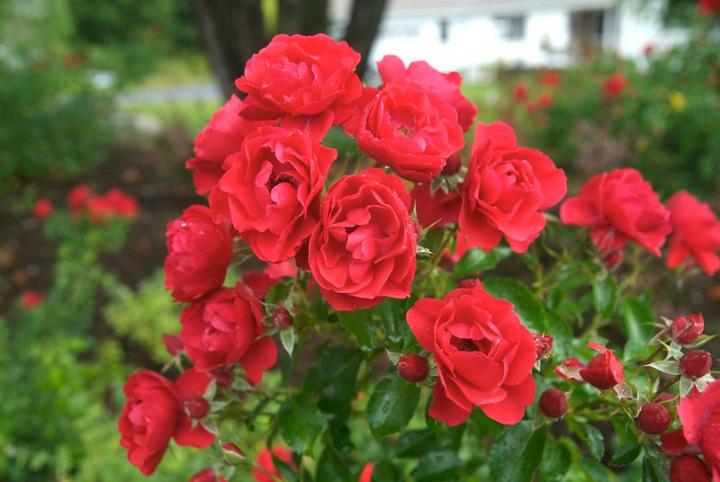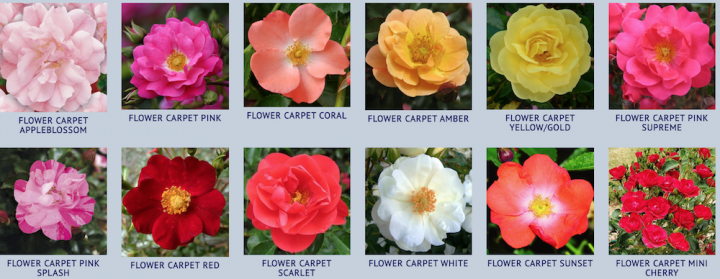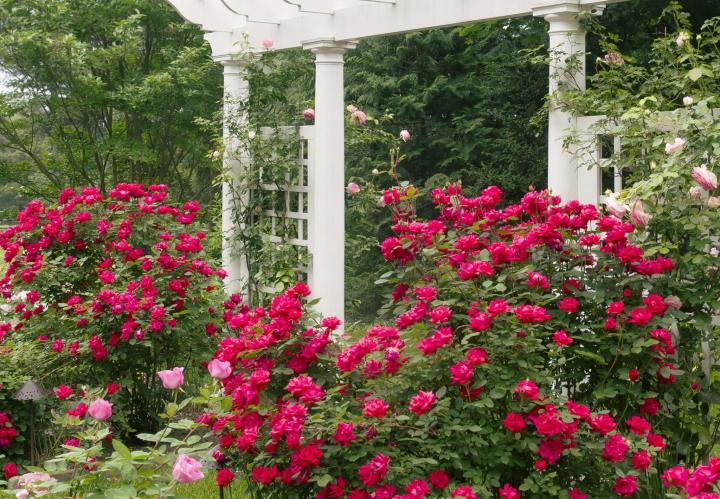| Roses once had a reputation for being finicky divas. However, rose breeders have bred disease out of this garden classic—without sacrificing the beauty and form that makes a rose a rose. Here are three of the most impressive and easiest roses to grow for any beginner. Put away the sprays; stop the fancy pruning. Just plant and savor these carefree roses year after year! |
| | Roses are traditionally very demanding and prone to many diseases, requiring lots of tender loving care. They have their place if you enjoy a high-maintenance prima donna, but so do a host of carefully bred, low-maintenance varieties. |  | Rose ‘Flower Carpet Amber’ is fragrant and attracts butterflies!
Anthony Tesselaar Plants | FLOWER CARPET ROSES
Enter the Flower Carpet® Rose, the world’s number one ground cover rose. I love its versatile, compact size—about 2 feet tall and 3 feet wide. Flower Carpet roses are especially known for a lengthy, prolific bloom from spring to late autumn—10 months in warmer climates! This rose is dripping in blossoms–up to 2,000 flowers per plant!
The foliage is resistant to common rose diseases (such as mildew and black spot), which means not only no spraying for you—but also no chemicals or pesticide for your garden. This plant also has a unique double root system (with deep roots as well as soil-surface ones), so it can also tolerate high heat, drought, and humidity. Surface roots take up available surface water while deeper roots access lower-level water in drought conditions. |  | | Flower Carpet® roses soften walkways, walls, house foundations, and hardscaping—and also cut back on edging! | Plus, Flower Carpet roses are incredibly adaptable. Plant in any season (spring, summer, or fall) in Zones 4 to 11. They bloom in both full sun as well as partial sun. In partial sun (2 to 3 hours per day), they just produce fewer flowers than when in full sun.
I plant these ground cover roses in beds and borders, but they also grow fabulously in containers, thanks to their compact size. Their dense, glossy, green leaves look wonderful even before the colorful roses begin to bloom with a good, mounded shape.
Planted en masse, they are useful on slopes to control erosion (no mowing!), as hedges around driveways (less edging!), as ground cover along sidewalks (instead of thirsty turf), and along walkways to soften up hardscape. |  | | Flower Carpet roses survive the drought, heavy rainstorms, and humid weather that can destroy less resilient roses. | Finally, there’s no fancy pruning. A simple cut-back (by one-third) each spring, a good mulching, fertilizer, and watering are all it takes to keep them blooming all summer long! Pruning is optional. If you do not have time or resources to do it, the roses will still flower profusely on a slightly larger bush.
It’s not surprising that Flower Carpet roses have received over 25 Gold and International Rose Awards. It’s hard to pick a favorite color! See 12 different rose varieties. |  | KNOCK OUT ROSES
Everyone knows the popular Knock Out® Rose, the traditional large shrub rose which grows about 4 feet tall and blooms in late spring and summer. Note: This rose does lose its leaves in winter, unlike the Flower Carpet® leaves, which change to a purple bronze color and remain on the plant until late in winter, leaving as little as two months of bare canes.
Knock Out Roses really do their best with 6 to 8 hours of full sun every day if you want constant flowers. They grow in Zones 5 to 10, so they’re a little more hardy in cold climates. This is important, as I can attest to having lost dozens of hybrid teas to -25ºF winters, no matter how much mulch I had heaped upon the plants. It’s also disease-resistant and stands up to heat, humidity, and the myriad diseases spawned by hot climates. I know this firsthand because I’ve lived and grown roses in places from the Gulf Coast to Wisconsin. No spraying and no dusting.
They also claim to be “no pruning,” but left unpruned, Knock Out roses can reach 8 feet tall. This is not beneficial, and the flowers will be less bold and healthy. I’d recommend pruning these shrubs, but not starting in their second season; cut back in early spring by as much as one-half after the last threat of frost has passed. |  | | The Double Knock Out® Rose has full double flowers and looks more like a classic rose. | | As well as the original Knock Out Rose, there is a Double Knock Out Rose which has full double flowers. To me, they’re prettier though smaller in size. While Knock Outs® aren’t supposed to need deadheading, I’d say the “Double” version really benefits to look its best. As with most shrubs, Knock Out Roses look best as a border or along a fence, wall, or foundation. If you plant within a garden landscape, I’d suggest planting in groups of three. See the Knock Out® Family of Roses. | DAVID AUSTIN CLIMBING ROSES
Then, there are some superb climbing roses. Unlike many climbing roses, the English Rose Climbers by David Austin® repeat flowering blooms with exceptional continuity and are clothed in blooms from the ground upward. As a group, they don’t grow too tall, making them easy to manage and the perfect height for appreciating the beauty and fragrance of their blooms.
I love David Austin roses; he and his family have bred the most beautiful rich scents of old varieties in a modern rose. When he started, very few modern roses had any fragrance.
An English climbing rose called ‘The Generous Gardener’ is one of the most fragrant, with glowing pale pink flowers and a scent of Old Rose, musk, and myrrh. It’s suitable for Zones 4 to 11 and climbs to 15 feet—perfect for a wall, fence, large arch, or pergola. |  | | Add an arch to your garden for a stunning centerpiece. Featured: the David Austin rose ‘The Generous Gardener’. | | Another rose that I’ve added to my home is the romantic ‘Claire Austin’, a medium climber which grows to about 12 feet with gorgeous, creamy white flowers. It’s also very fragrant, with strong myrrh and dashes of meadowsweet, vanilla, and heliotrope scents. It’s perfect against the side of your home or near the doorway, taking up little room on the ground. See more climbing roses from David Austin. | BARE-ROOT OR CONTAINER ROSES?
All of these easy-care roses come in two types: (1) bare-root and (2) container-grown. There are pros and cons to which type you buy:
(1) Bare-root roses. Bare-root roses are not in soil (hence, "bare") and are packed to prevent the roots from drying out. Bare-root plants are usually good-quality, having a wider root spread than container plants, and they are often of good value. They should be planted as soon as received or, if ground conditions are unsuitable, unpacked and kept in a container of slightly moist compost and planted as soon as conditions allow.
Plant bare-root roses in late autumn at leaf fall and from late winter to early spring, before growth resumes. Avoid planting in the middle of winter, when the ground is frozen.
Soak bare-root roses in a bucket of warm water overnight. Then dig a hole 18 inches wide and deep. Mix in compost if your soil is hard and compacted. In the center of the hole, make a 12-inch-high cone of dirt. Spread the rose roots over the cone. Hold the rose in place with one hand and fill in the hole with the other. Firm soil and water well.
(2) Container-grown roses. These are roses that have been grown in containers for a whole growing season or more. They can be more costly, but then again they are available year-round. And you can plant all year 'round, provided that the ground is neither frozen nor very dry. If you live in southern regions, container roses are a great choice because your ground and air temperatures are warmer.
Dig a hole the depth of the rose pot and 18 inches wide. Remove the plant from the pot, place it in center of the hole, spread the roots, and fill in with soil. Water well and firm the soil with the back of a shovel or your hands to eliminate air pockets. Scatter slow-release fertilizer formulated for roses around the plants and scratch in with a cultivator. | 5 ROSE TIPS THAT REALLY WORK
- Plant lavender at the base of rose bushes, especially the larger shrubs. Deer are attracted by rose scent, but lavender muddies the rose aroma.
- Dump coffee grounds and used tea leaves around bushes. Both acidify the soil slightly, which roses love.
- Bury banana skins or even the entire black, mushy banana at the base of bushes to provide magnesium, an element that the plants crave.
- Scratch 2 tablespoons of Epsom salts into the soil around a rose. The salts make flower colors more intense.
- Use rabbit food for fertilizer. The pet food is composed of alfalfa meal, which supplies a growth stimulant, nitrogen, and trace elements to roses. Scratch in ½ cup of pellets around each rose and water well.
I just love all of these carefree roses, and hope that you do, too! Whether you're looking for a more compact groundcover rose, a shrub, or a climber, you have choices to fit your garden and landscape needs. All of these roses are fantastic bloomers and don't need any spraying so you can practically forget about them. Everything's coming up roses! | | | | You received this email because you signed for updates from The Old Farmer's Almanac.
If you do not wish to receive our regular e-mail newsletter in the future,
please click here to manage preferences.
*Please do not reply to this e-mail*
© 2021 Yankee Publishing Inc. An Employee-Owned Company
1121 Main Street | P.O. Box 520 | Dublin, NH 03444
Contact Us
View web version | | | | |










No comments:
Post a Comment